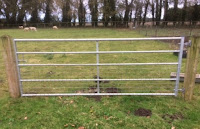There's a fair amount of paperwork that goes with being a smallholder, at least there is if you keep livestock. In fact the requirements are the same whatever size of livestock operation you operate.
A County Parish Holding (CPH) number needs to be applied for where animals are kept. Each type of livestock has to be registered with the Animal and Plant Health Agency (APHA). An annual census of sheep and goats, if you keep them, is required to be returned. A livestock register should be maintained and tagging details recorded so that each animal is traceable. Each animal movement on and off your holding has to be recorded and a movement licence completed. All medications administered have to be recorded in a medicines register, and lots more. There are also a whole range of regulatory requirements that should be adhered to. If you undertake any activities at a commercial level then further regulations and guidance come into play.
If you don't know what the requirements are it can seem a little overwhelming. I’ve met several farmers who decided to give up keeping livestock on their mixed farms because of the paperwork requirements. It also helps to explain the disappearance of so many of the smaller abattoirs.
I can understand farmers, after a hard days work outside, finding the paperwork side of things rather tedious. Others complain that it all seems unnecessary. It does not take long before the 'bureaucracy gone mad' position is put forward.
Despite all this, and the occasional puzzling regulatory anomalies one comes across, I would have reservations about any ideas of a wholesale sweeping away of regulations and record keeping. The reason behind them is the welfare of animals and also of consumers. While it's tempting to feel that the extent of the regulations is over the top, it has to be remembered that there have been outbreaks in recent years of disease or threats of disease that have been very serious if not catastrophic. Even in recent weeks there has been yet another food scandal involving a major meat processor which supplies the big supermarkets. In an unregulated system such consequences of the tendency to cut corners are likely to become endemic.
This is not to say that efforts should not be made to improve the regulations (including removing those that are unnecessary or anomalous or overly pedantic) to ensure they are fit for purpose. Many of the regulations are made with large scale producers and processors in mind and don't always quite fit for the smallholder. Some of the regulations around home slaughter, for example, don't all make sense. After all, one of the arguments for smallholding is that livestock can be better cared for in a smaller operation.
One of the fears of Brexit is that in the process of securing alternative trade deals there will be a scrapping or drastic reduction of regulations under pressure to create a ‘level playing field’ with new trade partners. The risk is that this will undermine the relatively higher animal welfare standards maintained in the UK.
There will always be a tension between animal welfare and profit or cost effectiveness, but it is right to give preferential bias to the former over the latter. Even if that means forgoing three frozen chickens for a tenner.

























